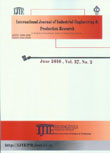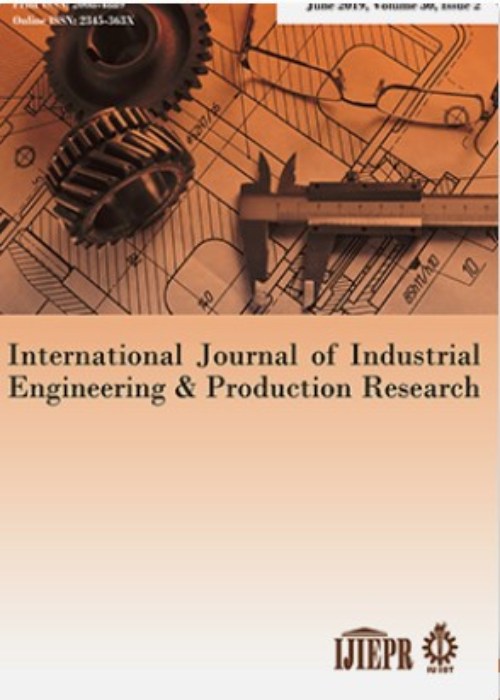فهرست مطالب

International Journal of Industrial Engineering and Productional Research
Volume:27 Issue: 3, Sep 2016
- تاریخ انتشار: 1395/07/10
- تعداد عناوین: 8
-
-
Pages 193-207In most of the multicriteria decisionanalysis (MCDA) problems in which the Choquet integral is used as aggregation function, the coefficients of Choquet integral (capacity) are not known in advance. Actually, they could be calculated by capacity definition methods. In these methods, the preference information of decision maker (DM) is used to constitute a possible solution space. The methods which are based on optimizing an objective function most often suffer from three drawbacks. Firstly, the selection of the ultimate solution from solution set is arbitrarily done. Secondly, the solution may provide more information than whatever proposed by DM. Thirdly, DM may not fully interpret the results. Robust capacity definition methods are proposed to overcome these kinds of drawbacks, on the other hand these methods do not consider evenness (uniformity) which is a major property of capacity. Since in capacity definition methods, the preference information on only a subset of alternatives called reference alternatives, is used, defining the capacity as uniform as possible could improve its capability in evaluating nonreference alternatives. This paper proposes an algorithm to define a capacity that is based only on the preference information of DM and consequently is representative. Furthermore, it improves evenness of capacity and consequently its reliability in evaluating nonreference alternatives. The algorithm is used to evaluate power plant projects. Power plant projects are of the most important national projects in Iran and a major portion of national capital is invested on them, so these projects should be scientifically evaluated in order to figure out their performance. Casespecific criteria are considered in addition to general criteria used in project performance evaluation. The evaluation results obtained from proposed algorithm are compared with those of the most representative utility function method.Keywords: aggregation operators, non-additive robust ordinal regression, multiple criteria decision making, uniform capacity
-
Pages 209-217Presently, emerging economies are acquiring singular positions all over the world. The complexities of nowadays economy have caused international companies and investors to be of a tendency towards emerging markets for more profitability and growth. This study aims to find the relationships between firm's profitability and growth in Iranian manufacturing industry consisting of Tehran Stock Market listed manufacturing firms covering 2005-2014. In order to understand the direction of causality between firm growth and profitability, we use system-GMM (Generalized Method of Moments) to estimate growth and profit regressions. The results obtained indicate that there is positively bilateral relationship between profitability and growth in the case of Iranian manufacturing firms. Also, we find the positive impact of current profit (growth) on current growth (profit) is stronger than the impact of the prior year.Keywords: Finance, Economics, Firm growth, profitability, Panel data, System-GMM
-
Pages 219-231Currently, due to increased competition in the services and manufacturing, many companies are trying to lower price and good quality products offer to the market. In this paper, the multi-criteria decision-making techniques to evaluate and select the best supplier from among the existing suppliers. The first, hierarchical structure for selecting suppliers of raw materials used and the analytic hierarchy process to obtain the relative importance of quantitative and qualitative criteria related to green supply chain is applied. Then, a fuzzy TOPSIS technique any raw material suppliers is ranked according to the relevant criteria. Finally, with regard to the weight of suppliers and demand of raw material and resource constraints by a multi-objective mathematical model, optimum order is determined. The objectives are to minimize the total cost, maximize amount of purchases of desirable suppliers and minimize of raw materials required are not provide. The proposed method in a case study used Food Company and the relevant results are expressed.Keywords: Supplier selection, order allocation, green supply chain, MOLP
-
Pages 233-242This paper considers a bi-objective mathematical model for locations of landfills, transfer stations and material recovery facilities (MRFs) in order to serve the entire regions and simultaneously identify the capacities of landfills. This is a mixed-integer programming (MIP) model, whose objectives are to minimize the total cost and pollution simultaneously. To validate the model, a numerical example is solved an augmented ε-constraint method and the associated computational results are presented to show the number of solid waste facilities and location of sites for solid waste facilities.Keywords: Solid waste management, Landfill location, Transfer station, Material recovery facilities, Capacity allocation
-
Pages 241-262Due to the particular importance of projects in human life and in organizations, proper project management has been always regarded highly by researchers and practitioners. Recent advances in technology and fundamental changes in most scientific areas have affected projects and made their nature and environmental circumstances much more complex than in the past. Fortunately, in recent years, many scholars have recognized the importance of complexity in modern project management and tried to identify its various aspects. Furthermore, one of the main factors for a projects success is the assignment of an appropriate project manager. Many studies have been done about project manager's competencies and the selection methods of a suitable project manager. In most of these researches, the amount and type of project complexity have been explained as influential factors for determining the competent project manager. However, a specific approach for project manager selection considering the complexity of projects is not provided yet. Hence, in this paper we try to design and implement a fuzzy group decision making approach to allocate the best project manager taking into account the project complexity. Also, owing to the importance of construction projects in the development of countrie's basic infrastructures, we exclusively studied this kind of projects. Finally, it should be noted that from the viewpoint of complexity theory, system complexity can exist in two forms: static and dynamic. Therefore, considering the breadth of issues related to each of these two complexity areas, just the static complexity of construction projects has been studied here.Keywords: Construction industry, Project manager, Competency, Static complexity, Fuzzy set theory, Group decision making
-
Pages 263-272Most manufacturers use human-machine systems to produce high-quality products. Dealing with human-machine systems is very complicated since not only machines should be utilized in proper condition but also appropriate environment should be provided for human resources. Most manufacturers have a maintenance plan for machines but many of them do not have a proper work-rest schedule for human resources. Considering this fact we emphasis on human role in human-machine systems maintenance and propose a mathematical model that obtains the optimal work-rest schedule for humans based on fatigue-recovery models and the optimal maintenance policy for machines based on reliability level. The performance of proposed model was examined by some instances and the obtained results indicate this model can provide effective maintenance policy for human-machine systems.Keywords: Maintenance, Human Resource, Fatigue, Recovery, Reliability
-
Pages 273-284Achieving optimal production cycle time for improving manufacturing processes is one of the common problems in production planning. During recent years, different approaches have been developed for solving this problem, but most of them assume that mean quality characteristic is constant over production run length and sets it on customers target value. However, the process mean may drift from an in-control to an out-of-control at a random point in time. This study aims to select the production cycle time and the initial setting of mean quality characteristic, so that the expected total cost, consisting of quality loss and maintenance costs as well as ordering and holding costs, already considered in the classic models is minimized. To investigate the effect of mean process setting, a computational analysis on a real world example is performed. Results show the superiority of the proposed approach compared to the classical economic production quantity model.Keywords: Production planning, deterioration process, production run length, mean quality characteristic, drift, Loss function
-
Pages 285-301In the recent decade, special attention is paid to reverse logistic due to economic benefits of recovery and recycling of used products as well as environmental legislation and social concerns. On the other hand¡ many researches claim that separately and sequential planning of forward and reverse logistic causes sub-optimality. Effective transport activities are also one of the most important components of a logistic system and it needs an accurate planning. In this study, a mixed integer linear programming model is proposed for integrated forward / reverse supply chain as well as vehicles routing. Logistic network which is used in this paper is a multi-echelon integrated forward /reverse logistic network which is comprised capacitated facility, common facilities of production/recovery and distribution/collection, disposal facilities and customers. The proposed model is multi-period and multi-product with the ability to consider several facilities in each level. Various types of vehicle routing models are also included such as multi-period routing, multi-depot, multi-products, routing with simultaneous delivery and pick-up, flexible depot assignment and split delivery. The model results present the product flow between the various facilities in forward and reverse direction throughout the planning horizon with the objective minimization of total cost. Numerical example for solving the model using GAMS shows that the proposed model could reach the optimal solution in reasonable time for small and medium real worlds problems.Keywords: Closed loop supply chain, Binary programming, vehicle routing, simultaneous pick-up, delivery


